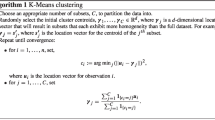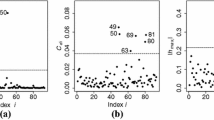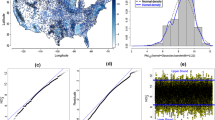Abstract
In recent decades, there has been a growing interest in modeling spatial–temporal data, which can be found in many fields including geoscience, meteorology and ecology, among many others. The spatial–temporal dependence structure modeling, using a random field approach, is an indispensable tool to estimate the parameters that define this structure. However, this estimation may be greatly affected by the presence of atypical observations in the sampled data. Our proposal is to extend the results of Uribe-Opazo et al. (J Appl Stat 39:615–630, 2012) and De Bastiani et al. (Test 24:322–340, 2015) in the studies of diagnostic techniques to assess the sensitivity of the maximum likelihood estimators to small perturbations in the response variable for the spatial–temporal linear models with separable covariance. The method’s viability is illustrated in a simulation study, and in an application to eggs anchovy (Engraulis ringens) abundance data in ichthyoplankton surveys from the northern zone of Chile. The results show that the proposed methodology allows to detect influential observations in a spatial-temporal data set when their covariances are separable.












Similar content being viewed by others
References
Amani A, Lebel T (1997) Lagrangian kriging for the estimation of Sahelian rainfall at small time steps. J Hydrol 192:125–157
Anderson T (1973) Asymptotically efficient estimation of covariance matrices with linear structure. Ann Stat 1(1):135–141
Assumpção RAB, Uribe-Opazo MA, Galea M (2011) Local influence for spatial analysis of soil physical properties and soybean yield using Student-t distribution. Rev Bras Ciência do Solo 35:1917–1926
Assumpção RAB, Uribe-Opazo MA, Galea M (2014) Analysis of local influence in geostatistics using Student-t distribution. J Appl Stat 41:2323–2341
Aziz Ezzat A, Jun M, Ding Y (2019) 09. Spatio-temporal short-term wind forecast: a calibrated regime-switching method. Ann Appl Stat 13:1484–1510. https://doi.org/10.1214/19-AOAS1243
Bai L, Feng J, Li Z, Han C, Yan F, Ding Y (2022) 06. Spatiotemporal dynamics of surface ozone and its relationship with meteorological factors over the Beijing–Tianjin–Tangshan region, China, from 2016 to 2019. Sensors 22:4854. https://doi.org/10.3390/s22134854
Barlow A, Rohrbeck C, Sharkey P, Shooter R, Simpson E (2018) 09. A Bayesian spatio-temporal model for precipitation extremes-stor team contribution to the eva2017 challenge. Extremes. https://doi.org/10.1007/s10687-018-0330-z
Bevilacqua M, Morales-Oñate V (2018) GeoModels: a package for geostatistical Gaussian and non Gaussian data analysis. R package version 1.0.3-4
Bonicelli P, J, Días RJ, Cifuentes OU, Osorio ZF, Bustamante M, Berger MT, Grendi CC, Claramunt QG, Herrera UG, Moreno GP, Azócar SC, Catasti BV (2021) Informe final. Condiciones bio-oceaográficas y evaluaciń del stock desovante de anchoveta entre las regiones de Arica y Parinacota y Antofagasta, año 2020. IFOP
Bonicelli P, J, Días RJ, Cifuentes OU, Osorio ZF, Bustamante MA, Cornejo DM, Grendi CC, Herrera CL, Santander PE, Claramunt QG, Angulo AJ, Herrera UG, Moreno GP, Azócar SC, Catasti BV, Leiva DF (2020) Informe final. Condiciones bio-oceaográficas y evaluaciń del stock desovante de anchoveta entre las regiones de Arica y Parinacota y Antofagasta, año 2019. IFOP
Bonicelli P, J, Días RJ, Cifuentes OU, Osorio ZF, Bustamante MA, Pizarro RM, Grendi CC, Herrera CL, Santander PE, Claramunt QG, Angulo AJ, Herrera UG, Moreno GP, Azócar SC, Catasti BV (2019) Informe final. Condiciones bio-oceaográficas y evaluación del stock de anchoveta entre la XV y II regiones, año 2018. IFOP
Borssoi JA, De Bastiani F, Uribe-Opazo MA, Galea M (2011) Local influence of explanatory variables in Gaussian spatial linear models. Chil J Stat 2:29–38
Box GEP, Cox DR (1964) An analysis of transformations. J R Stat Soc Ser B 26(2):211–252
Carroll R, Chen R, George E, Li T, Newton H, Schmiediche H, Wang N (1997) Ozone exposure and population density in Harris county, Texas (with discussion). J Am Stat Assoc 93:392–415
Chatterjee S, Hadi A (1998) Sensitivity analysis in linear regression. Wiley, New York
Christakos G (2000) Modern spatiotemporal geostatistics, 2nd edn. Oxford Univ. Press, Oxford
Christensen R (1992) Prediction diagnostics for spatial linear models. Biometrika 79:583–591
Christensen R (1993) Covariance function diagnostics for spatial linear models. Math Geol 25:145–160
Claramunt G, Castro L, Cubillos L, Hirche H, Perez G, Braun M (2012) Inter-annual reproductive trait variation and spawning habitat preferences of Engraulis Ringens off northern Chile. Rev Biol Mar Oceanogr 47(2):227–243
Cook R (1977) Detection of influential observation in linear regression. Technometrics 19:15–18
Cook R (1986) Assessment of local influence. J R Stat Soc Ser B 48:133–169
Cook R, Weisberg S (1982) Residuals and influence in regression. Chapman & Hall, London
Cressie N (1994) Comment on “an approach to statistical spatial-temporal modeling of meteorological fields’’ by M. S. Handcock and J. R. Wallis. J Am Stat Assoc 89:379–382
Cressie N, Shi T, Kang EL (2010) Fixed rank filtering for spatio-temporal data. J Comput Graph Stat 19:724–745
Cressie N, Wikle CK (2011) Statistics for spatio-temporal data. Wiley, New York
De Bastiani F, Mariz de Aquino A, Uribe-Opazo M, Galea M (2015) Influence diagnostics in elliptical spatial linear models. Test 24:322–340
Diamond P (1984) Robustness of variograms and conditioning of kriging matrices. Math Geol 16:809–822
Fassò A, Cameletti M, Nicolis O (2007) Air quality monitoring using heterogeneous networks. Environmetrics 18:245–264
Galea M, Paula GA, Bolfarine H (1997) Local influence in elliptical linear regression models. The Statistician 46:71–79
Garcia-Papani F, Uribe-Opazo MA, Leiva V, Aykroyd RG (2017) Birnbaum–Saunders spatial modelling and diagnostics applied to agricultural engineering data. Stoch Environ Res Risk Assess 31(1):105–124
Gneiting T (2002) Nonseparable, stationary covariance functions for space-time data. J Am Stat Assoc 97(458):590–600
Goodall C, Mardia KV (1994) Challenges in multivariate spatio-temporal modeling. In: Proceedings of the xviith international biometric conference. Volume 39, pp 1–17
Grzegozewski DM, Uribe-Opazo MA, De Bastiani F, Galea M (2013) Local influence when fitting Gaussian spatial linear models: an agriculture application. Ciência e Investigação Agrária 40:235–252
Guttorp P, Meiring W, Sampson PD (1994) A space-time analysis of ground-level ozone. Environmetrics 5:241–254
Haslett J, Raftery A (1989) Space-time modelling with long-memory dependence: assessing Ireland’s wind power resource. Appl Stat 38:1–50
Heaton M, Gelfand A (2012) Kernel averaged predictors for spatio-temporal regression models. Spat Stat 2:15–32. https://doi.org/10.1016/j.spasta.2012.05.001
Hering A, Genton M (2010) 03. Powering up with space-time wind forecasting. J Am Stat Assoc 105:92–104. https://doi.org/10.1198/jasa.2009.ap08117
Huang H, Hsu N (2004) Modeling transport effects on ground-level ozone using a non-stationary space-time model. Environmetrics 15:251–268
Johnson SR, Heaps SE, Wilson KJ, Wilkinson DJ (2021) Bayesian spatio-temporal model for high-resolution short-term forecasting of precipitation fields
Kyriakidis PC, Journal AG (1999) Geostatistical space-time models: a review. Math Geol 31:651–684
Li L, Jiehao Z, Qiu W, Wang J, Fang Y (2017) 0.5. An ensemble spatiotemporal model for predicting pm2.5 concentrations. Int J Environ Res Public Health 14:549. https://doi.org/10.3390/ijerph14050549
Lindström J, Szpiro A, Sampson P, Oron A, Richards M, Larson T, Sheppard L (2014) 09. A flexible spatio-temporal model for air pollution with spatial and spatio-temporal covariates. Environ Ecol Stat 21:411–433. https://doi.org/10.1007/s10651-013-0261-4
Liu S (2000) On local influence in elliptical linear regression models. Stat Pap 41:211–224
Matérn B (1986) Lecture Notes in Statistics, vol 36, 2nd edn. Springer, Berlin
Meiring W, Sampson PD, Gutterop P (1998) Space-time estimation of grid-cell hourly ozone levels for assessment of a deterministic model. Environ Ecol Stat 5:197–222
Minasny B, McBratney A (2005) The matérn function as a general model for soil variograms. Geoderma 128(3–4):192–207
Nicolis O, Diaz M, Sahu K, Marin J (2019) Bayesian spatio-temporal modelling for estimating short-term exposure to air pollution in Santiago De Chile. Environmetrics 30:e2574
Osorio F, Paula GA, Galea M (2007) Assessment of local influence in elliptical linear models with longitudinal structure. Comput Stat Data Anal 51:4354–4368
Poon W, Poon Y (1999) Conformal normal curvature and assessment of local influence. J R Stat Soc Ser B 61:51–61
R Core Team (2021) R: a language and environment for statistical computing. R Foundation for Statistical Computing, Vienna
Rychlik I (2015) 01. Spatio-temporal model for wind speed variability. Annales de l’Institut de Statistique de l’Universite de Paris, ISSN: 1626-1607 59: 25–55
Sahu S, Nicolis O (2008) An evaluation of European air pollution regulations for particulate matter monitored from a heterogeneous network. Environmetrics 20(8):943–961
Serra R, Aguayo M, Rojas O, Cañón J, Inostroza F (1979) Anchoveta Engraulis ringens (jenyns) teleostomi clupeiformes engraulidae. In: Estado actual de las principales pesquerías nacionales. bases para un desarrollo pesquero: I peces. CORFO-IFOP (eds.) AP 79-18: 1–52
Sigrist F, Künsch H, Stahel W (2011) 02. A dynamic nonstationary spatio-temporal model for short term prediction of precipitation. Ann Appl Stat. https://doi.org/10.1214/12-AOAS564
Smith R, Kolenikov S, Cox L (2003) 12. Spatio-temporal modeling of pm2.5 data with missing values. J Geophys Res. https://doi.org/10.1029/2002JD002914
Stauffer R, Mayr G, Messner J, Umlauf N, Zeileis A (2016) 11. Spatio-temporal precipitation climatology over complex terrain using a censored additive regression model. Int J Climatol. https://doi.org/10.1002/joc.4913
Stroud J, Müller P, Sansó B (2001) 02. Dynamic models for spatiotemporal data. J R Stat Soc Ser B 63:673–689. https://doi.org/10.1111/1467-9868.00305
Uribe-Opazo M, De Bastiani F, Galea M, Schemmer R, Botinha R (2020) Influence diagnostics on a reparameterized \(t\)-student spatial linear model. Spat Stat 41:100481
Uribe-Opazo MA, Borssoi JM, Galea M (2012) Influence diagnostics in gaussian spatial linear models. J Appl Stat 39:615–630
Valenzuela V, J, Moreno P, Azócar C, Cifuentes U, Grendi C, Claramunt G, Herrera G, Díaz E, Bohm G, Saavedra-Nievas J, Pizarro M (2016) Informe final. Evaluación de stock desovante de anchoveta en la XV, I y II y regiones, año 2014. IFOP
Warnes J (1986) A sensitivity analysis for universal kriging. Math Geol 18:653–676
Wikle C, Zammit-Mangion A, Cressie N (2019) Spatio-temporal statistics with R. Chapman & Hall/CRC the R series. CRC Press, Taylor & Francis Group, London
Yang G, Liu Y, Li X (2020) 04. Spatiotemporal distribution of ground-level ozone in china at a city level. Sci Rep 10:7229. https://doi.org/10.1038/s41598-020-64111-3
Yanosky J, Paciorek C, Laden F, Hart J, Puett R, Liao D, Suh H (2014) 08. Spatio-temporal modeling of particulate air pollution in the conterminous united states using geographic and meteorological predictors. Environ Health 13:63. https://doi.org/10.1186/1476-069X-13-63
Zhang H (2004) Inconsistent estimation and asymptotically equal interpolations in model-based geostatistics. J Am Stat Assoc 99(465):250–261
Zhang H (2012) Asymptotics and computation for spatial statistics. In: Porcu E, Montero J-M, Schlather M (eds) Advances and challenges in space-time modelling of natural events. Springer, Berlin Heidelberg, pp 239–252
Zhang H, El-Shaarawi A (2010) On spatial skew-gaussian processes and applications. Environmetrics 21:33–47
Zhang H, Zimmerman D (2007) Hybrid estimation of semivariogram parameters. Math Geol 39(2):247–260
Zhu H, Ibrahim J, Lee S, Zhang H (2007) Perturbation selection and influence measures in local influence analysis. Ann Stat 35(6):2565–2588
Zhu H, Lee S (2001) Local influence for incomplete-data models. J R Stat Soc Ser B B63:111–126
Acknowledgements
The authors would like to thank to the Instituto de Fomento Pesquero (IFOP), which provided the data that was used in the application of this paper, especially to the staff that participated of the anchoveta Spawning Monitoring Project (MPDH) ejecuted by IFOP and funded by the Chilean Ministry of Economy, Promotion and Tourism (Asesoría Integral en Pesca y Acuicultura, ASIPA). Juan Carlos Saavedra-Nievas acknowledges funding from the CONICYT (Comisión Nacional de Investigación Científica y Tecnológica, Chile) for its scholarship "Becas de Doctorado Nacional" for PhD studies (CONICYT-PCHA/Doctorado Nacional/2014-21140088).
Author information
Authors and Affiliations
Corresponding author
Additional information
Communicated by Luiz Duczmal.
Appendix A: The observed information matrix
Appendix A: The observed information matrix
The observed information matrix for Gaussian spatial–temporal linear models is obtained from the second derivative of the loglikelihood function (9) and defined by \(\mathrm {I(\varvec{\theta })}=\partial ^2{\mathcal {L}}(\varvec{\theta })/\partial \varvec{\theta }\partial \varvec{\theta }^T=-{{\textbf{L}}}(\varvec{\theta })\) evaluated at \(\varvec{\theta }=\hat{\varvec{\theta }}\), where \({{\textbf{L}}}(\varvec{\theta })\) is the Hessian matrix given by
where
with elements,
where \(\pmb {\epsilon }={{\textbf{Y}}}-{{\textbf{X}}}\varvec{\beta }\) and considering \(\varvec{\Sigma } = \varvec{\Sigma _s} \otimes \varvec{\Sigma _t} = \big (\phi _1 {{\textbf{I}}}_{n_s} + \phi _2 \mathbf {R_s}(\tau )\big ) \otimes \mathbf {R_t}(\phi _3)\) and
we have,
where
Therefore,
where \(L_{\phi _1\phi _2} = {{\textbf{0}}}\). Considering the Matérn model to describe the temporal variability given in (8), we have that \(\partial \mathbf {R_t}(\phi _3)/\partial \phi _3 = \left[ \partial r_{ij}/\partial \phi _3\right] \) and \(\partial ^2\mathbf {R_t}(\phi _3)/\partial \phi _3^2 = \left[ \partial ^2 r_{ij}/\partial \phi _3^2\right] \), where for
and
with \(i \ne j, i,j=1,\ldots ,n\).
Rights and permissions
Springer Nature or its licensor (e.g. a society or other partner) holds exclusive rights to this article under a publishing agreement with the author(s) or other rightsholder(s); author self-archiving of the accepted manuscript version of this article is solely governed by the terms of such publishing agreement and applicable law.
About this article
Cite this article
Saavedra-Nievas, J.C., Nicolis, O., Galea, M. et al. Influence diagnostics in Gaussian spatial–temporal linear models with separable covariance. Environ Ecol Stat 30, 131–155 (2023). https://doi.org/10.1007/s10651-023-00556-9
Received:
Accepted:
Published:
Issue Date:
DOI: https://doi.org/10.1007/s10651-023-00556-9




